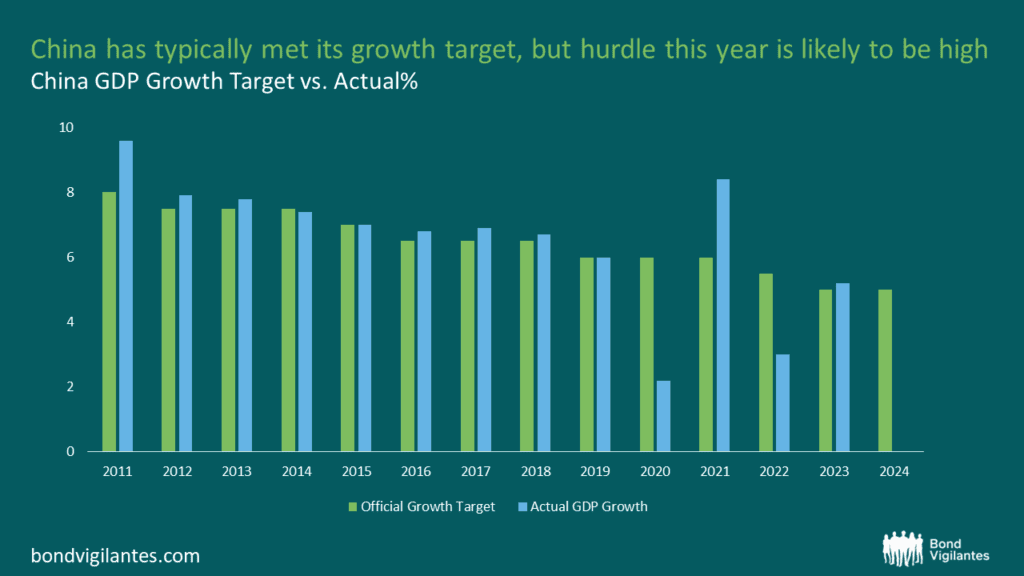China: Supportive Policies Aim to Bolster Growth Amid Challenges
Since the onset of the year, Chinese authorities have embarked on strategic measures to stabilize the capital market and bolster economic growth. The People’s Bank of China (PBOC) has taken significant steps, including a 50 basis point cut in the reserve requirement ratio (RRR) – the largest since 2021 — followed by a historic 25 basis point decrease in the 5-year Loan Prime Rate (LPR). These policy actions have significantly boosted market sentiment, as reflected in the recent uplift in the Chinese stock market. These measures also align with our expectation of a supportive policy landscape in China for 2024.
Navigating Economic Challenges to Achieve Ambitious 2024 Goals
The National People’s Congress (NPC) session in March established an economic growth target of around 5% for 2024, echoing last year’s goal and aligning with market expectations. However, the pursuit of this target is poised to be more challenging for the government this year due to a higher baseline and persisting economic headwinds, such as weakened domestic demand, industry oversupply, and diminished consumer and business confidence. Although we do not foresee a “bazooka-style” stimulus package as our base scenario, we anticipate the introduction of additional, coordinated policy support initiatives to reinforce market confidence and ensure sustainable growth beyond the immediate horizon.

Source: Bloomberg, M&G, March 2024
Proactive Measures to Support Economic Expansion
In this context, fiscal policy is expected to remain expansionary. The central government has taken a more proactive fiscal approach since late 2023, including issuing RMB 1 trillion in central government bonds.
The NPC’s official work report also signalled plans to issue 1 trillion yuan ($139 billion) in ultra-long special central government bonds this year, with a fiscal deficit target of 3%, unchanged from last year. These additional special bond issuances are not included in the official deficit calculation. Including these bonds, we project the country’s deficit could approach 4% of GDP. We also anticipate an increase in the Special Local Government Bond (SLGB) quota to RMB 4.0 trillion, with an expansion in the permissible use of these funds to foster growth.
Ensuring Credit Flow to Sustain Growth
The monetary policy stance is expected to remain accommodating to support real credit demand. Although no specific monetary policy measures will be announced at the NPC, we anticipate additional easing through various structural monetary policy tools, such as Pledged Supplementary Lending and targeted relending schemes. This approach is likely to be complemented by further reductions in the RRR, Medium Lending Facility (MLF) rate, and Loan Prime Rate (LPR) in the coming months.
Policy Interventions to Address Sectoral Weaknesses
Furthermore, we expect more detailed property-specific policies to be unveiled at the NPC to address the sector’s ongoing weaknesses. More information on the “three major projects”—affordable housing construction, shanty town redevelopment, and the development of public infrastructure for both regular and emergency use—is anticipated, aligning with the Central Financial Work Conference’s directive last October to expedite efforts related to these projects. Additional policy support aimed at enhancing the supply of social housing, potentially including the acquisition of unsold private projects by local governments for conversion into public housing, is also anticipated.
The supportive measures and policy announcements from China signify a concerted effort to sustain economic growth and market stability. While these developments are broadly in line with expectations, they underscore the government’s commitment to navigating the current economic challenges. While the fiscal deficit target for 2024 is kept unchanged, the absolute size of the fiscal deficit is expected to increase by RMB 180 billion to RMB 4.06 trillion, surpassing 4 trillion for the first time in history.
Implications for Investors
We will monitor the progress of fiscal spending and local government bond issuances to assess if the support on the economy is sustained and how various sectors benefit from them. We also await further sector-specific announcements, such as those on property sector, which can provide clues to the extent of policy support for the sector and the potential trajectory from here.
Another area of investment opportunity, for example, could be bonds issued by local governments financing vehicles (LGFV). LGFVs play critical roles in infrastructure investments and promotion of economic growth, in line with the government’s focus this year. Liabilities of LGFVs are also expected to be lightened through the issuances of special refinancing local government bonds that can be used to pay down the LGFV debt, as well as other refinancing options that help extend their debt duration and reduce funding costs. There may be selective opportunities in high quality LGFV bonds with strategic importance and proven track record.
The dovish monetary policy stance will, however, keep China onshore bond yields low. Since December, the 10-year China government bond yield has fallen by 40 bps to a record low of 2.28% (7 Mar 24). The fall in onshore bond yields has reduced the appeal of China onshore bonds compared to USD-denominated bonds issued by similarly rated China entities. As such, we will maintain our preference for exposure in China USD credit, as opposed to onshore RMB-denominated ones, while we wait for better entry opportunities in the onshore space.
The value of investments will fluctuate, which will cause prices to fall as well as rise and you may not get back the original amount you invested. Past performance is not a guide to future performance.










